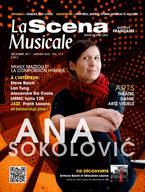 |
| Joël Quarrington - Crédit Anis Hammoud/CQM |
Opus 18 - saison 2013-2014
par Réjean Beaucage
C'est le 1erfévrier dernier que le Conseil québécois de la musique remettait ses prix Opus, qui soulignent l'excellence en musiques de concert (classique, contemporaine, jazz, du monde, électroacoustique ou actuelle).
Il faut bien dire que le monde de la musique au Québec est tout de même un peu plus diversifié que ce que nous en laisse entrevoir la remise annuelle des prix Opus, où l'on retrouve souvent, d'une fois à l'autre, les mêmes personnalités qui viennent (ou pas) chercher leur joli trophée. Ainsi de Yannick Nézet-Séguin, qui recevait l'année dernière le prix du « Rayonnement à l'étranger » (qu'il n'a, bien entendu, pas volé), et qui était récompensé deux fois cette année pour le même concert donné avec l'Orchestre Métropolitain et la pianiste Hélène Grimaud (« Concert de l'année – musiques romantique, postromantique, impressioniste » et « Concert de l'année – Montréal »), ou des Violons du Roy, qui règnent en maîtres dans la Vieille Capitale et qui recevaient le prix du « Concert de l'année – Québec » pour Solomon, de Haendel, dirigé par Bernard Labadie, avec Karina Gauvin et Marie-Nicole Lemieux, après l'avoir obtenu l'année dernière pour Theodora, de Haendel, dirigé par Bernard Labadie, avec Karina Gauvin et Marie-Nicole Lemieux... On ne discute pas de l'excellence des artistes en cause, ici, mais d'une reconnaissance qui pourrait être un tout petit peu moins « ciblée ».
De nombreux facteurs font en sorte que l'on revoit les mêmes visages sur la scène d'une édition à l'autre, mais ça prouve généralement surtout que les personnes en question ont des carrières actives, ce dont on ne peut évidemment que se réjouir. Pensons au pianiste Yves Léveillé, qui recevait l'Opus du « Concert de l'année – jazz et musiques du monde » (nouvelle fusion de ces deux catégories) après avoir reçu le même prix l'année dernière (catégorie « jazz ») pour le concert En trois couleurs (trio Simard, Bourassa, Léveillé). Pensons aussi à Maxime McKinley, « Compositeur de l'année » en 2012-2013 et auteur de l'« Article de l'année » cette fois-ci, pour un texte paru dans la revue Circuit, musiques contemporaines, dont le rédacteur en chef, Jonathan Goldman, montait lui aussi sur scène, mais à titre de musicien au sein de l'ensemble Quartango(« Disque de l'année – musiques du monde », avec Encuentro).
Comme l'OM, le festival de musique de chambre Concerts aux Îles du Bic a également reçu deux prix pour le même concert, soit le programme L'extase française, qui offrait des œuvres de Fauré, Emmanuel, Hahn, Debussy, Poulenc et Franck (« Concert de l'année – régions » et « Répertoires multiples »). Notons enfin que la fondatrice du Nouvel Ensemble Moderne, Lorraine Vaillancourt, est aussi montée deux fois sur scène pour recevoir le prix remis au « Concert de l'année – musiques moderne, contemporaine » (pour le programme célébrant le 25eanniversaire du NEM) et pour celui remis à la « Direction artistique de l'année ».
 |
| Crédit: Anis Hammoud/CQM |
Création
C'est à l'opéra Le rêve de Grégoire de Pierre Michaud, une coproduction de Chants Libres et de la Société de musique contemporaine du Québec, que l'on a remis l'Opus de la « Création de l'année », tandis que le quatuor de saxophones Quasar, qui lançait tout récemment sa 20e
saison, recevait le prix du « Concert de l'année – musiques actuelle, électroacoustique » pour son programme De souffles et de machines, coproduit avec le Centre interdisciplinaire de recherche en musique, médias et technologie (CIRMMT) dans le cadre du premier Printemps numérique. Le compositeur Pierre Alexandre Tremblay, qui avait une œuvre en création lors de ce concert de Quasar, a quant à lui reçu l'Opus du « Disque de l'année – musiques actuelle, électroacoustique » pour La marée, chez empreintes DIGITALes (son disque précédent avait aussi remporté ce prix en 2010-2011).
C'est à Samy Moussa que sont allés l'Opus du « Compositeur de l'année » et les 10 000 $ qui l'accompagnent (gracieuseté du CALQ). Moussa était aussi en lice pour la création de l'année avec sa pièce A Globe Itself Infolding, créée par l'OSM au concert d'inauguration de l'orgue Casavant de la Maison symphonique; l'OSM donnera le 17 février prochain la création d'un Nocturne qu'il a commandé à Moussa. Par ailleurs, les inaugurations du Casavant de l'OSM et de celui du Palais Montcalmà Québec constituent un autre doublé, qualifié d'« Événement musical de l'année ». Et c'est l'OSM qui repart avec l'Opus du « Rayonnement à l'étranger » cette année.
Chez nous, c'est la pianiste Louise Bessette qui rayonnait en 2013-2014 en offrant en quatre concerts un programme de 25 œuvres couvrant les 25 dernières années pour saluer le 25e anniversaire de la Chapelle historique du Bon-Pasteur et, par le fait même, les 25 ans de Guy Soucie à la barre de l'institution montréalaise. La pianiste est repartie avec l'Opus de l'« Interprète de l'année » et les 5 000 $ que le CAC y attache. La « Découverte de l'année » est le chef d'orchestre Andrei Feher que l'on a vu à l'OM et qui est aussi chef assistant à l'OSQ. Enfin, le Prix Hommage état remis cette année à Johanne Goyette, fondatrice de la maison de disque ATMA Classique.
Pour tous les détails, consultez le site du CQM à http://www.cqm.qc.ca
























.jpg)



.jpg)




